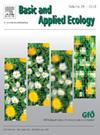Short-term mating success in relation to fluctuating wing asymmetry in the male azure damselfly Coenagrion puella
IF 3.5
2区 环境科学与生态学
Q2 ECOLOGY
引用次数: 0
Abstract
As top flying predators, damselflies rely on wing symmetry and functionality. However, already during aquatic larval development, environmental stressors, including anthropogenic ones, can affect their development and impair wing morphology raising the question whether such alterations affect reproductive fitness. To investigate the role of wing morphology in mating success, we collected males of Coenagrion puella observed in copulation wheels (indicating short-term mating success) or actively chasing other wheel or tandem formations (unsuccessful mating attempts at the time of capture). Twenty individuals of each group were collected at two locations differing in environmental and anthropogenic pressures: one regularly used for recreational fishing and surrounded by agriculture in the Rhine Valley and one consisting of research ponds in the Palatinate Forest with restricted public access. Wing morphology and symmetry were assessed via computer-vision by comparing several cell shape and position dependent variables as well as wing size and number of cells and junctions using the recently developed software WingAnalogy. Mating males in the Palatinate Forest exhibited higher cell shape asymmetry than mating males in the Rhine Valley. In these individuals, the cell shape asymmetry was more pronounced in the distal part of the wing than in the proximal part. Mating males had lower body weight (-5%) and smaller wings (-3%) compared to chasing males at both locations. Our results challenge the general theory that stress-induced lower body weight and higher asymmetry diminish short-term mating success. Instead, they underscore the ecological importance of population-specific factors, like female availability or male-male competition, and environmental conditions that shape mating dynamics. Our results suggest that anthropogenic stressors in aquatic habitats have implications for terrestrial food webs by affecting the reproductive interactions of adult amphibiotic top predators, such as damselflies. This highlights the need to consider cross-ecosystem carry-over effects in ecological monitoring and conservation strategies.
蓝色豆娘翅不对称与短期交配成功的关系
作为顶级掠食者,豆娘依靠翅膀的对称和功能。然而,在水生幼虫的发育过程中,环境压力因素,包括人为因素,可以影响它们的发育和损害翅膀的形态,这就提出了这样的改变是否会影响生殖适应性的问题。为了研究翅膀形态在交配成功中的作用,我们收集了在交配轮(表明短期交配成功)或积极追逐其他轮或串列(捕获时未成功交配)中观察到的雄性Coenagrion puella。每组20只在环境和人为压力不同的两个地点收集:一个经常用于休闲钓鱼,被莱茵河流域的农业所包围,另一个由普法尔茨森林的研究池塘组成,公众进入受限。使用最近开发的软件WingAnalogy,通过比较几个细胞形状和位置依赖变量以及翅膀大小、细胞数量和连接,通过计算机视觉来评估翅膀的形态和对称性。普法尔茨森林的交配雄虫比莱茵河谷的交配雄虫表现出更高的细胞形状不对称性。在这些个体中,细胞形状的不对称在翅膀的远端比在近端更明显。与在两个地点追逐的雄性相比,交配的雄性体重更轻(-5%),翅膀更小(-3%)。我们的研究结果挑战了一般的理论,即压力导致的低体重和高不对称性会降低短期的交配成功率。相反,他们强调了种群特定因素的生态重要性,比如雌性可利用性或雄性竞争,以及塑造交配动态的环境条件。我们的研究结果表明,水生栖息地的人为压力源通过影响成年两栖顶级捕食者(如豆娘)的生殖相互作用,对陆地食物网产生了影响。这突出了在生态监测和保护战略中需要考虑跨生态系统的携带效应。
本文章由计算机程序翻译,如有差异,请以英文原文为准。
求助全文
约1分钟内获得全文
求助全文
来源期刊

Basic and Applied Ecology
环境科学-生态学
CiteScore
6.90
自引率
5.30%
发文量
103
审稿时长
10.6 weeks
期刊介绍:
Basic and Applied Ecology provides a forum in which significant advances and ideas can be rapidly communicated to a wide audience. Basic and Applied Ecology publishes original contributions, perspectives and reviews from all areas of basic and applied ecology. Ecologists from all countries are invited to publish ecological research of international interest in its pages. There is no bias with regard to taxon or geographical area.
 求助内容:
求助内容: 应助结果提醒方式:
应助结果提醒方式:


